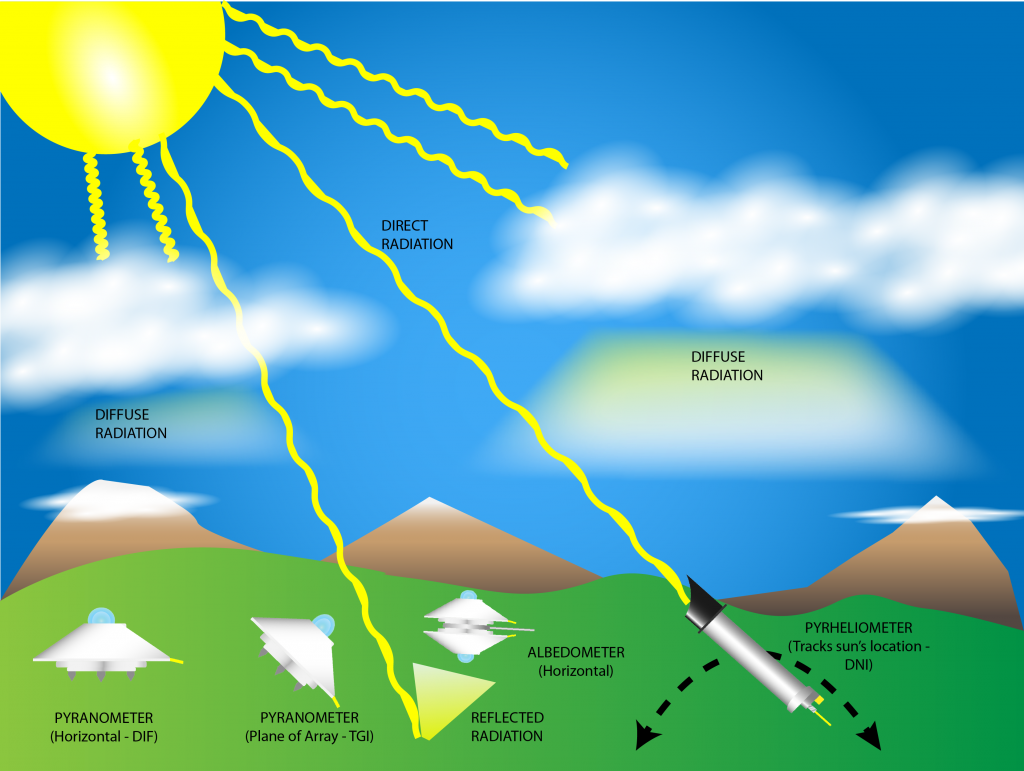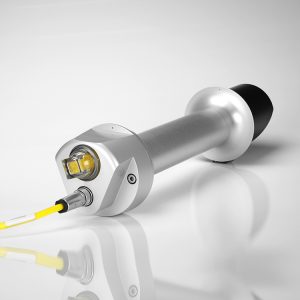
limited to 5°,
A pyrheliometer is a solar irradiance sensor (radiometer) that measures the direct beam radiation of the sun (Direct Normal Irradiance, DNI). Pyrheliometers differ from pyranometers that measure diffuse radiation (Global Horizontal Irradiance, GHI). Radiation scattered by atmospheric particles (e.g. clouds) or reflected off objects is diffuse radiation. In both cases, the SI units used are watts per square meter (W/m²). Our article on solar irradiance provides more information.
How pyrheliometers measure DNI
As pyrheliometers measure direct beams of light it is critical they always point directly at the sun. When mounted to sun tracking instruments such as the Kipp and Zonen SOLYS2 sun tracker, pyrheliometers can accurately track the Sun’s location throughout the year. Sun trackers precisely move/rotate on two axes. As a result, the pyrheliometer is able to track the east to west movement and the vertical position of the sun concurrently. Complex calculations in the SOLYS’ software mean it ‘knows’ the position of the sun at all times.
To measure a narrow beam of light the pyrheliometer sensor must restrict its field of view. Kipp and Zonen SHP1 pyrheliometers restrict field of view to 5° through the shape of the collimation tube, precision apertures, and the detector design.
In contrast, a pyranometer has a 180° field of view to capture total irradiance when on a horizontal plane. A consequence of the carefully designed glass domes.

To make observations and measurements pyrheliometers utilise a thermopile sensor (collection of thermocouples which turn thermal energy into a small electrical current). The thermopiles’ black coating absorbs solar radiation. This causes a temperature difference between the hot and cold junctions of the thermopile. Which in turn, generates a very small voltage proportional to the solar radiation absorbed. Therefore, a greater temperature difference produces a larger voltage output. As a result, after temperature correction, the outputted voltage provides data on irradiance.
Pyrheliometer applications
Pyrheliometers have been a “go-to” instrument for measuring solar irradiance in the meteorology and climatology disciplines. The data on the irradiance received on areas of Earth are key variables in the climate and weather models calculated on supercomputers. So much so, that pyrheliometers are subject to World Meteorological Organization (WMO) and ISO standards. As a result, every 5 years at the World Radiation Centre in Davos, Switzerland, organisations being pyrheliometers for data comparison. During this event, pyreheliometers collectively measure the input from the sun (which is the same for all), allowing such comparisons and ‘recalibration’.
Solar farms
However, a new application for pyrheliometers is rapidly growing. Between 2010 and June 2020, Australia installed 1,137 large-scale photovoltaic systems. Large-scale solar is over 100kW e.g. large commercial rooftop installation to solar farms. In 2018 and 2019 alone a total of 5,074,561 kW was registered, this accounts for over 82% of solar installed between 2010 to June 2020. Solar farms are now as large as several football fields. With such large amounts of panels, scaling of minor improvements is possible. As such instruments such as pyrheliometers and pyranometers are becoming increasingly popular. The data they provide allows estimations on solar output, this can be compared with actual figures. Discrepancies may indicate faulty or dirty panels.
Solar irradiance sensors are also used in the planning stage of solar farms. Studies will provide data on the amount of sunlight a site can expect to receive annually. Comparisons between multiple sites can help identify microclimates that are either beneficial or detrimental to a solar farm.
If you are prospecting a potential solar farm site and need any solar irradiance sensors then please do not hesitate to contact ESS Earth Sciences for information and pricing.



